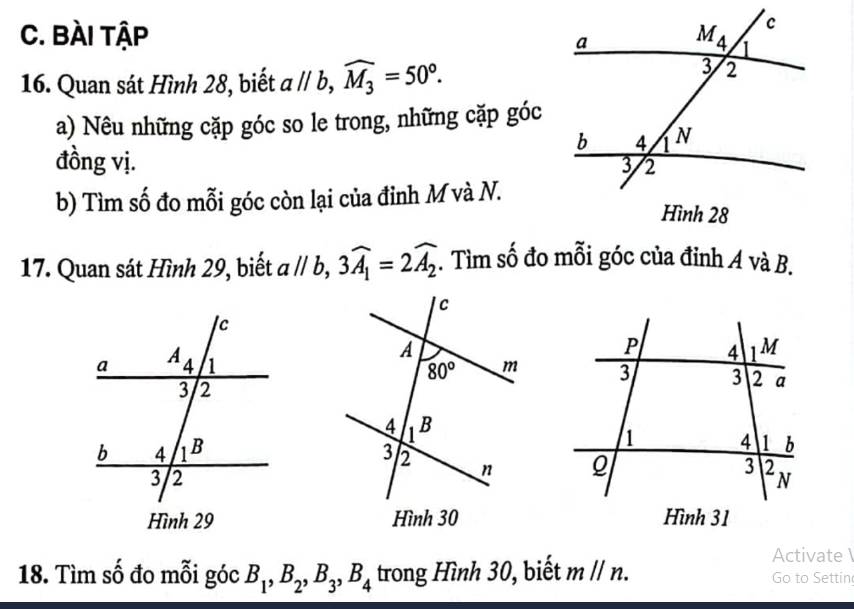
Hãy nhập câu hỏi của bạn vào đây, nếu là tài khoản VIP, bạn sẽ được ưu tiên trả lời.


\(11x^2-15x+4=0\)
\(\Leftrightarrow11x^2-11x-4x+4=0\)
\(\Leftrightarrow11x\left(x-1\right)-4\left(x-1\right)=0\)
\(\Leftrightarrow\left(x-1\right)\left(11x-4\right)=0\)
\(\Leftrightarrow\left[{}\begin{matrix}x-1=0\\11x-4=0\end{matrix}\right.\)
\(\Leftrightarrow\left[{}\begin{matrix}x=1\\x=\dfrac{4}{11}\end{matrix}\right.\)
\(S=\left\{1,\dfrac{4}{11}\right\}\)
Đặt C(x)=0
\(\Leftrightarrow11x^2-15x+4=0\)
\(\Leftrightarrow11x^2-11x-4x+4=0\)
\(\Leftrightarrow11x\left(x-1\right)-4\left(x-1\right)=0\)
\(\Leftrightarrow\left(x-1\right)\left(11x-4\right)=0\)
\(\Leftrightarrow\left[{}\begin{matrix}x-1=0\\11x-4=0\end{matrix}\right.\Leftrightarrow\left[{}\begin{matrix}x=1\\11x=4\end{matrix}\right.\Leftrightarrow\left[{}\begin{matrix}x=1\\x=\dfrac{4}{11}\end{matrix}\right.\)
Vậy: Nghiệm của đa thức \(C\left(x\right)=11x^2-15x+4\) là 1 và \(\dfrac{4}{11}\)

Ta có: x+y+1=0
nên x+y=-1
Ta có: \(N=x^2\left(x+y\right)-y^2\left(x+y\right)+x^2-y^2+2\left(x+y\right)+3\)
\(=\left(x+y\right)\left(x^2-y^2\right)+\left(x^2-y^2\right)+2\left(x+y\right)+3\)
\(=\left(x^2-y^2\right)\left(x+y+1\right)+2\left(x+y\right)+3\)
\(=\left(x^2-y^2\right)\cdot0+2\cdot\left(-1\right)+3\)
=-2+3=1

Đáp án:
P=\(\frac{2}{3}\)
Giải thích các bước giải:
x:y:z=5:4:3
⇒ x5x5 =y4y4 ⇒y= 4x54x5
⇒ x5x5 =z3z3 ⇒z= 3x53x5
Thay vào biểu thức ta được:
P= x+2y−3zx−2y+3zx+2y−3zx−2y+3z= x+2.4x5−33x5x−2.4x5+33x5x+2.4x5−33x5x−2.4x5+33x5 =4x56x54x56x5 =2323
Vậy P=\(\frac{2}{3}\)
# Chúc bạn học tốt!
Vì x,y,z tỉ lệ với các số 5,4,3 nên ta có : \(x:y:z=5:4:3\) hoặc \(\frac{x}{5}=\frac{y}{4}=\frac{z}{3}\)
Ta lại có : \(\frac{x}{5}=\frac{y}{4}=\frac{z}{3}=\frac{x}{5}=\frac{2y}{8}=\frac{3z}{9}\)
Đặt \(\frac{x}{5}=\frac{2y}{8}=\frac{3z}{9}=k\Rightarrow\hept{\begin{cases}x=5k\\2y=8k\\3z=9k\end{cases}}\)
\(P=\frac{x+2y-3z}{x-2y+3z}=\frac{5k+8k-9k}{5k-8k+9k}=\frac{4k}{6k}=\frac{4}{6}=\frac{2}{3}\)
Vậy \(P=\frac{2}{3}\)

`@` `\text {Ans}`
`\downarrow`
`16,`
`@` Các cặp góc đồng vị:
`+`\(\widehat {M_4}\) và \(\widehat {N_4}\)
`+`\(\widehat {M_1}\) và \(\widehat {N_1}\)
`+`\(\widehat {M_2}\) và \(\widehat {N_2}\)
`+`\(\widehat {M_3}\) và \(\widehat {N_3}\)
`@` Các cặp góc sole trong:
`+`\(\widehat {M_3} \) và \(\widehat {N_1}\)
`+`\(\widehat {M_2}\) và \(\widehat {N_4}\)
`b,`
Ta có: \(\widehat {M_3} = \widehat {M_1} (\text {đối đỉnh})\)
`=>`\(\widehat {M_1}=50^0\)
\(\widehat {M_3}+\widehat {M_2}=180^0 (\text {kề bù})\)
`=>`\(50^0+\widehat {M_2}=180^0\)
`=>`\(\widehat {M_2}=180^0-50^0=130^0\)
\(\widehat {M_2}=\widehat {M_4} (\text {2 góc đối đỉnh})\)
`=>`\(\widehat {M_4} = 130^0\)
Vì \(\widehat {M_3}\) và \(\widehat {N_1}\) là `2` góc sole trong
`=>`\(\widehat {M_3}=\widehat {N_1}=50^0\)
\(\widehat {M_3}=\widehat {N_3}=50^0 (\text {2 góc đồng vị})\)
\(\widehat {M_2}=\widehat {N_2}=130^0 (\text {2 góc đồng vị})\)
\(\widehat {M_2}=\widehat {N_4}=130^0 (\text {2 góc slt})\)
`17,`
Vì \(\widehat {A_1}\) và \(\widehat {A_2}\) là `2` góc kề bù
`=>`\(\widehat {A_1}+\widehat {A_2}=180^0\)
\(3\widehat {A_1}=2\widehat {A_2}\) (gt)
`=>`\(\widehat{A_1}=\dfrac{2}{3}\cdot\widehat{A_2}\)
Thay \(\widehat{A_1}=\dfrac{2}{3}\widehat{A_2}\)
\(\dfrac{2}{3}\cdot\widehat{A_2}+\widehat{A_2}=180^0\)
`=>`\(\widehat{A_2}\left(\dfrac{2}{3}+1\right)=180^0\)
`=>`\(\widehat{A_2}\cdot\dfrac{5}{3}=180^0\)
`=>`\(\widehat{A_2}=180^0\div\dfrac{5}{3}\)
`=>`\(\widehat{A_2}=108^0\)
Vậy, số đo \(\widehat{A_2}=108^0\)
\(\widehat {A_1}+\widehat {A_2}=180^0 (\text {kề bù})\)
`=>`\(\widehat{A_1}+108^0=180^0\)
`=>`\(\widehat{A_1}=72^0\)
\(\widehat {A_1}=\widehat {A_3}=72^0 (\text {đối đỉnh})\)
\(\widehat {A_2}=\widehat {A_4}=108^0 (\text {đối đỉnh})\)
`@` Số đo các góc của đỉnh B:
`+`\(\widehat {A_4}=\widehat {B_4}=108^0 (\text {đồng vị})\)
`+`\(\widehat {A_2}=\widehat {B_2}=108^0 (\text {đồng vị})\)
`+`\(\widehat {A_3}=\widehat {B_1}=72^0 (\text {sole trong})\)
`+`\(\widehat {A_3}=\widehat {B_3}=72^0 (\text {đồng vị})\)